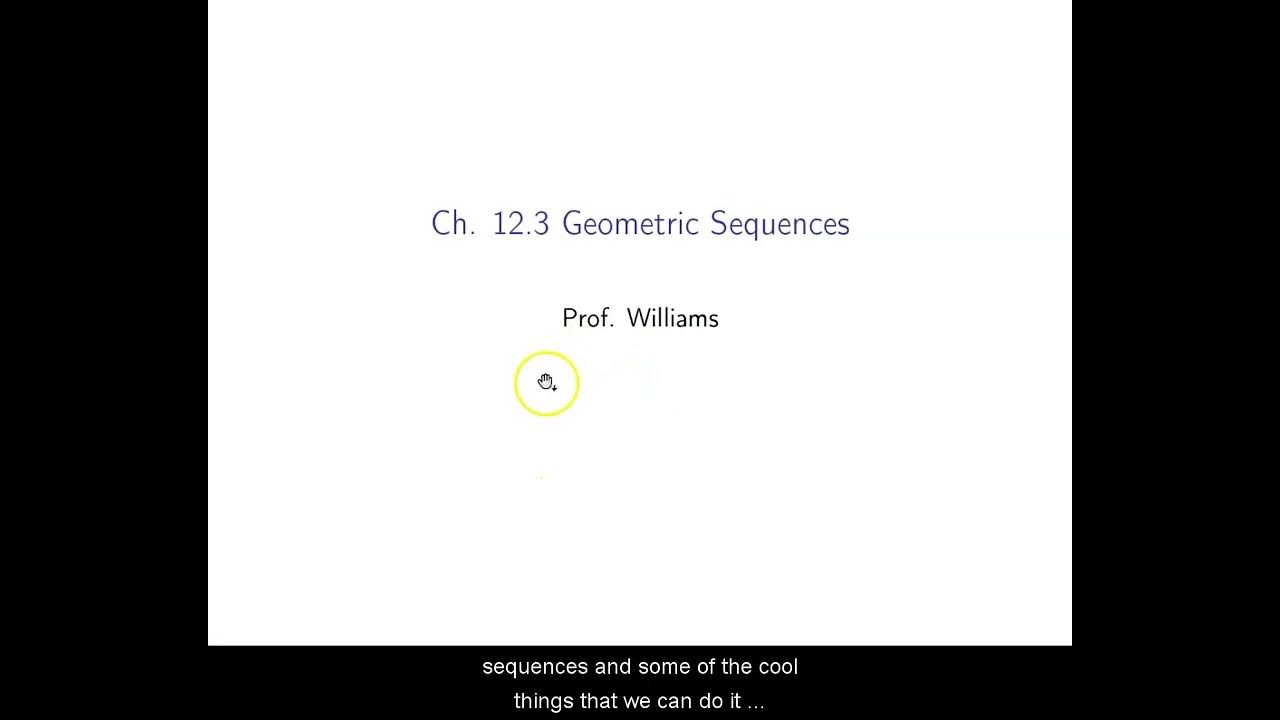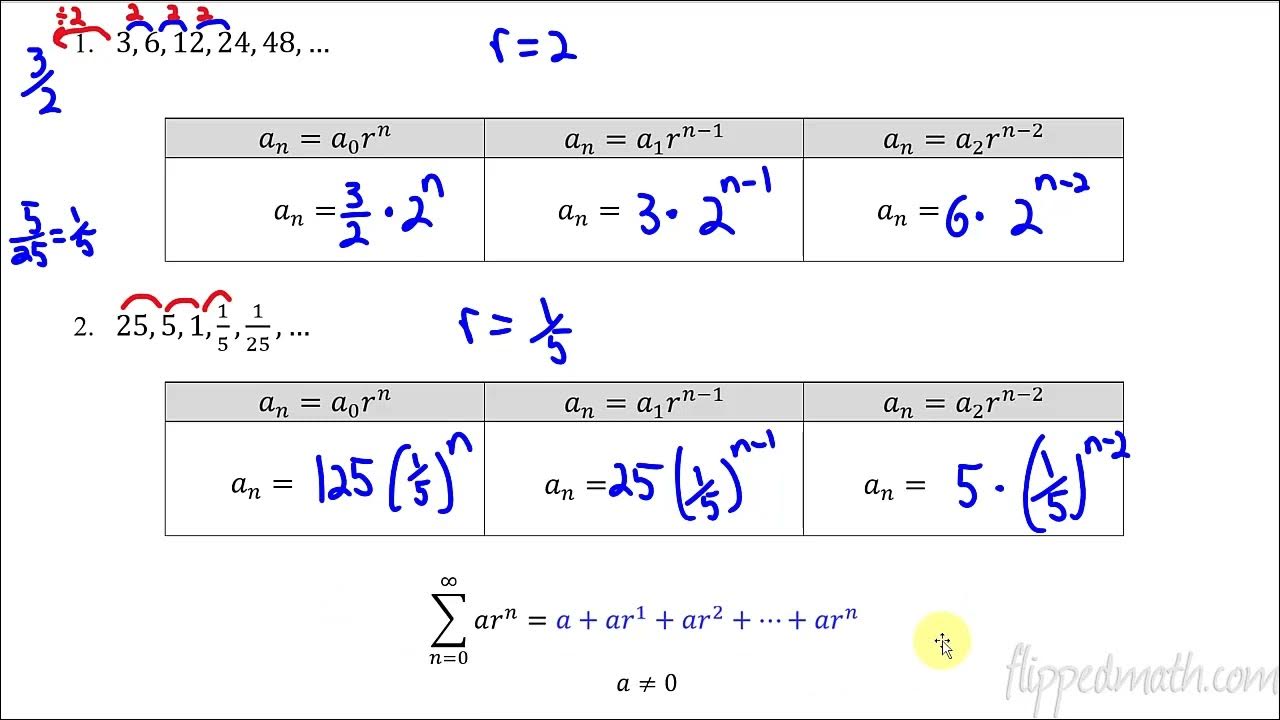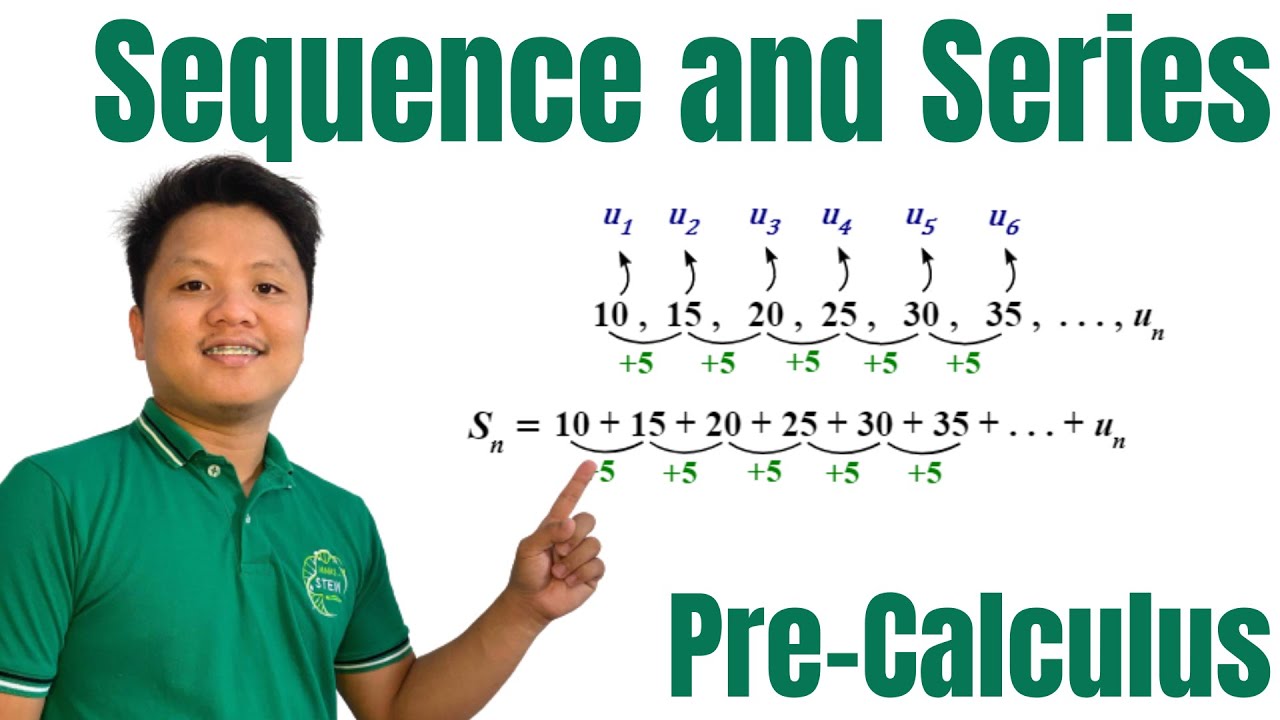Sequences and Series (part 1)
TLDRThis script introduces the concepts of sequences and series, focusing on arithmetic and geometric progressions. It explains how to represent the sum of an arithmetic series using Sigma notation and derives a formula for its sum. The script also touches on the concept of geometric series and hints at a method for their summation, which will be explored in a subsequent video.
Takeaways
- 📈 A sequence is an ordered list of numbers.
- 📊 A series is the sum of a sequence.
- 🔢 The arithmetic series involves the sum of consecutive integers.
- 🤔 Sigma notation (Σ) is a shorthand way to represent the sum of a sequence without listing each term.
- 📚 The formula for the sum of the first N natural numbers is given by S = N * (N + 1) / 2.
- 🔄 Adding the arithmetic series in reverse order yields the same result, which helps in deriving the sum formula.
- 🎩 The video also introduces the concept of the geometric series, which involves the sum of powers of a common ratio.
- 📈 Geometric growth is a type of growth where each term is multiplied by a fixed ratio.
- 🧠 The video hints at a trick for summing a geometric series, which will be explored in the next installment.
- 🚀 The arithmetic series sum formula can be used for quick calculations, such as adding numbers from 1 to 100 or 1 to 1000.
- 💡 The video emphasizes the practical applications of understanding series, both for theoretical knowledge and real-world problem-solving.
Q & A
What is the definition of a sequence?
-A sequence is a list of numbers arranged in a specific order.
How is a series related to a sequence?
-A series is the sum of the numbers in a sequence.
What is an arithmetic series?
-An arithmetic series is the sum of an arithmetic sequence, where each term is obtained by adding a constant difference to the previous term.
What is the formula for the sum of an arithmetic series?
-The sum of an arithmetic series can be calculated using the formula: S = N * (N + 1) / 2, where N is the number of terms.
What is the purpose of Sigma notation?
-Sigma notation is used to represent the sum of a sequence without having to write out each term. It simplifies the expression of series sums.
How does the order of addition affect the sum of numbers?
-The order of addition does not affect the sum of numbers. Whether you add numbers in forward or reverse order, the total will remain the same.
What is a geometric series?
-A geometric series is the sum of a geometric sequence, where each term is obtained by multiplying the previous term by a fixed non-zero number.
What is the general form of a geometric series?
-The general form of a geometric series is the sum from k = 0 to N of a to the power of k, denoted as Σ(a^k) from k = 0 to N.
What is geometric growth?
-Geometric growth refers to the pattern of growth where each term after the first is found by multiplying the previous term by a fixed, non-zero number.
Why are arithmetic and geometric series important?
-Arithmetic and geometric series are important because they are commonly encountered in various fields such as finance, science, and mathematics. They provide a way to model and calculate the behavior of certain types of sequences and their sums.
How can the knowledge of series be used for quick calculations?
-Understanding series allows for quick calculations of sums that would otherwise take a long time to compute manually. By using formulas for arithmetic and geometric series, one can rapidly find the sum of a large sequence of numbers.
Outlines
📚 Introduction to Sequences and Series
This paragraph introduces the concepts of sequences and series. A sequence is a list of numbers in a specific order, while a series is the sum of a sequence. The content explains the arithmetic series as the sum of an arithmetic sequence and introduces Sigma notation as a way to represent these sums without writing out each term. The paragraph also sets the stage for a deeper exploration into the arithmetic and geometric series, hinting at their importance in calculus and Taylor series.
🧮 Formula Derivation for Arithmetic Series
The second paragraph delves into the arithmetic series, providing a method to sum these series using a formula. It demonstrates a clever algebraic manipulation to derive the formula for the sum of the first N natural numbers. The content also illustrates how this formula can be used to quickly calculate the sum of numbers in a range, such as from 1 to 100 or 1 to 1000, offering a practical application of the concept. This section emphasizes the utility of mathematical formulas in simplifying complex calculations and their potential for impressive quick computations.
Mindmap
Keywords
💡Sequence
💡Series
💡Sigma Notation
💡Arithmetic Series
💡Geometric Series
💡Summation
💡Variable
💡Power Series
💡Taylor Series
💡Low-end Parlor Tricks
Highlights
A sequence is defined as a bunch of numbers in some order.
The concept of a series is introduced as the sum of a sequence.
Arithmetic series is explained as the sum of an arithmetic sequence.
Sigma notation is introduced for representing sums without writing out each term.
The formula for the sum of an arithmetic series is derived using a clever method of adding corresponding terms.
The sum of an arithmetic series is shown to be N times (N+1)/2.
A practical application of the arithmetic series formula is demonstrated by quickly calculating the sum from 1 to 100.
The concept of a geometric series is introduced, with a focus on the common ratio.
Geometric series is described as involving a variable 'a' raised to the power of 'k'.
The idea of geometric growth is linked to the concept of a geometric series.
A method for finding the sum of a geometric series is hinted at, involving a new sum 'aS'.
The video content is designed to be engaging and educational, with a focus on mathematical concepts that are often seen in finance and science.
The arithmetic series is emphasized as a fundamental concept that is essential to understand before moving on to more advanced series like the geometric series.
The video provides a clear and concise explanation of mathematical concepts, making them accessible to a wide audience.
The use of practical examples, such as quickly summing numbers, helps to illustrate the power and utility of mathematical formulas.
The video promises to cover power and Taylor series in future content, indicating a progression from basic to advanced mathematical concepts.
Transcripts
Browse More Related Video

Introduction to Series and Summation Notation (Precalculus - College Algebra 68)

Ch. 12.3 Geometric Sequences

Geometric Sequences (Precalculus - College Algebra 71)

Calculus BC – 10.2 Working with Geometric Series

Geometric series | Sequences, series and induction | Precalculus | Khan Academy

Sequence and Series | Terms of Sequence and Associated Series | Pre-Calculus
5.0 / 5 (0 votes)
Thanks for rating: